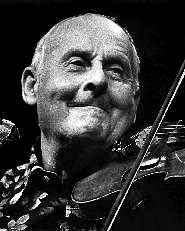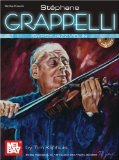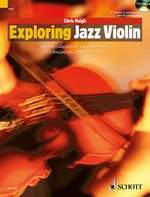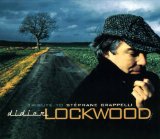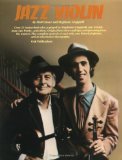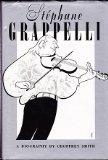
MENU TO FIDDLE STYLES:
Stephane Grappelli (1908-'97)
It is rare with any jazz instrument that the field is so dominated by one musician as is the case with Stephane Grappelli and the jazz violin. True, the field is not large; jazz violinists with an international reputation are numbered in the dozens rather than the hundreds. Nevertheless, through his style and technique, the longevity of his career, the vastness of his discography, not to mention his personal charm, Grappelli has earned a place among the giants of jazz.
Born in 1908 in Paris, he had a hard upbringing. His mother died when he was 4, and his father was forced to put him in an orphanage when he was called up to fight in World War 1. He was given his first violin at the age of 14, and his father taught him to read music and play scales; he soon started making money, busking around the courtyards of Paris. He studied piano in the Paris Conservetoire from the age of 16 to 20, working in his spare time as a pianist accompanying silent films in the cinema. He later became as a member of Gregor and his Gregorians, the leading French showband of the time, again playing piano. It was Gregor who heard Grappelli playing violin on night, and realised that here was not just a good pianist, but an outstanding violinist, and persuaded him to play the violin full-time.
The most important turning point in Grappelli’s career came in 1934 when he met gypsy guitarist Django Reinhardt in the Croix de Sud nightclub in Montparnasse. In the words of Grappelli, “one day he was strumming his guitar, and I started to improvise with him”. Both were already familiar with the work of the American duo Joe Venuti and Eddie Lang, and they quickly realised that here was an opportunity for them to try and make the same kind of hot, swinging string jazz music. With the addition of two rhythm guitars and a double bass they created a band; since their first engagement was organized by the Hot Club de France, they became known as the Quintette du Hot Club de France. Django and Stephane were an unlikely partnership; the former an illiterate, tempestuous gypsy, as likely as not to miss a recording session in order to go fishing, but nevertheless regarded as a true genius on his instrument, whilst Grappelli was punctilious, urbane and sophisticated. The band was an immediate success, and was quickly recognised as the first of its kind; a string band, and one with a distinctively European rather than American voice..
They played together up until the outbreak of World War 2, performing widely, recording extensively and writing what were to become the standards of the Hot Club style- numbers such as Minor Swing, Djangology, Nuages and Swing 39.
At the outbreak of war they were performing in London; Reinhardt returned to Paris, but Grappelli stayed in England, where he began playing with the blind pianist George Shearing. They were reunited in 1945, but by this time Reinhardt’s musical direction was changing, with more use of electric guitar and more of a bebop sensibility. The quintette was never really re-established, and Grappelli’s carreer went into a slow decline.
Two events were to bring him back to prominence; the first was an appearance in 1971 on the Parkinson Show with classical violin virtuoso Yehudi Menuhin; the idea was to put together two musical opposites to see how they would make out. In fact it was a huge success with the public, and lead to a series of further appearances and six albums. The partnership is still talked about today. Among jazz musicians there is a tendency to sneer at Menuhin’s less than perfect attempt to swing (all his solos were written out and played note-for note, whilst Grappelli, of course, could relax and was completely in his element.) It has to be said that as a meeting of two styles, the territory was very much Grappelli’s, and Menhuin was surely very brave in playing completely outside his own field. The partnership gave a huge boost to Grappelli’s flagging popularity, and introduced him to a huge middle class art- loving public who may previously have had little interest in jazz, let alone jazz violin.
In 1973 Stephane Grappelli was invited by British guitarist Diz Disley to appear at the Cambridge Folk Festival, and caused a sensation. The way was now clear for a return to performing at the highest level; he played constantly from then on, first with Disley, then with a variety of other lineups, including many with guitarist Martin Taylor. He was still performing right up to his death in 1997.
He left a prodigious body of recording; apart from those with the artists mentioned above, he produced albums with guitarists Barney Kessel and Joe Pass, pianists Oscar Peterson, Earl Hines and McCoy Tyner, and Vibes player Gary Burton. He had a particular liking for working with other violinists, and recorded with Eddie South, Joe Venuti, Stuff Smith,, Svend Asmussen, Jean Luc Ponty,Mark O’Connor, Vassar Clements and the L.Subramaniam.
Stephane Grappelli's Violin style
Stephane Grappelli’s playing style can best be described as elegant, relaxed and flowing. He produced a constant stream of perfectly executed melodic phrases, often at very high speed and with a minimum of effort. He rarely practiced, apart from when he was rehearsing with a band, and said of his performances “you play better when you’re not thinking of what you’re doing”.
He had a very distinctive fast, tight vibrato, which he used deliberately but sparingly, and used very light finger pressure. He often used a mute, and particularly on ballads he employed a soft, intimate, whispering tone. His bow rarely left the string, and he was a master at producing great flurries of notes with only a tiny amount of bow movement, mostly near the tip.
His improvisational style was very melodic, mostly using diatonic scales based around the tonal centre. He constantly used phrases from the major blues scale, with flattened thirds and fifths. He drew on a huge stockpile of riffs and melodic motifs, which when you’ve listened to enough of his recordings become very recognisable. There are certain “trademark” techniques he used repeatedly, such as playing a series of third-position harmonics; playing runs in double-stopped fifths across two strings, and playing left-hand pizzicato across the open strings at the start or end of a phrase or section. He made frequent use of repeated triplets, and often played phrases which climbed dizzyingly to the very top of the neck, whilst always maintaining perfect intonation.
His tone, apart from when deliberately playing very softly, was bright, warm and clean. Although he would mostly swing, with great accuracy and precision, he also made very effective use of rubato, gliding lazily across the beats and the barlines.His on-stage persona was part of his charm; always elegantly dressed, he played with his eyes half closed with a look of pure bliss and serenity on his face- a feeling he readily transmitted to his audience. Undoubtedly a large factor in his enduring popularity is the nostalgic association between him and the lost, romantic dream of prewar Paris.
__________________________________________________________________________
Mel Bay Presents Stephane Grappelli Gypsy Jazz Violin

For years there has been a shelf full of books available for gypsy-jazz guitarists, as well as a fair pile of general jazz violin tutors, mostly trying to cover the full range of jazz styles. Now at last there’s a book specifically for those fiddlers who want to learn the style of Stephane Grappelli, written by Tim Kliphuis, himself a master Grappelli stylist.
The book opens up with a clear and simple explanation of the relationship between scales and chords, targeted at the crucial II, V, I sequence and, important for gypsy jazz, the difference between harmonic and melodic minor scales. An entertaining exercise with walking feet and clicking fingers (based I’m sure on Tim’s extensive workshop experience) introduces the idea of on and off beats, and eases you into the idea of swing vs straight playing.
One of the biggest problems I find with converting classical players to jazz is the way they want to bow every note evenly. Kliphuis gets right to the point, introducing the idea of “ghost notes” which receive a bow length of approximately nil- they are swallowed up and become a mere suggestion. The contrast of these ghost notes with the accented notes is a crucial nuance of jazz fiddling which I have rarely seen described elsewhere.
The distinctive Grappelli vibrato and harmonics get a look-in, followed by some valuable suggestions on bowing, slurs and accents. The addition of extra chromatic notes to scales turns them into swinging, fluid melodic phrases rather than stilted exercises. For melodic instruments like the violin, arpeggios are particularly important in jazz playing, and Kliphuis shows how the addition of 6th, 7th and 9th notes, and starting below the tonic, can make them far more useable in jazz soloing.
My pet hate for jazz fiddle books is when you’re given huge transcriptions of solos. Go on, admit it. You’re one of those people who bought a certain Grappelli book, sat down and tried playing through the first page. You got no more than twelve bars into the first solo, sighed and went to make a cup of tea. That’s as far as you got. I know, I was one of those people. Kliphuis provides six such transcriptions but, mercifully, he then breaks each one down into short, useable phrases, pointing out examples of blue notes, sliding notes, anticipation of chord changes, altered notes and rubato phrasing.
No review would be complete without some petty griping. I would like to have heard more audio tracks of the short phrases which I found so valuable, to have had more examples of Grappelli’s many “stock” licks, such as the use of parallel fifths, and to have had a fuller explanation of the blues scales which are so fundamental to Grappelli’s playing.
Nevertheless I would say to anyone learning to play Grappelli style fiddling that this is what it sets out to be, THE book that you’ve just got to have.
__________________________________________________________________________________
Tribute to Stephanie Grappelli

If I had to recommend a single cd of jazz violin of all the ones I’ve ever listened to, this would be it. Lockwood was a protégé of Grappelli in the 1970’s, and absorbed many of the most endearing stylistic traits of the older player. This is heard most clearly on the slow ballads such as Les Valseuses, My one and Only Love. Misty and Tears, where the breathy tone and broken phrasing are pure Grappelli. Lockwood’s rendition of Nuages is the one I always play to students to demonstrate his absolute mastery of harmonics, both natural and artificial, as well as the way in which such incredible depth and expression can be squeezed into 32 bars of melody. Didier Lockwood may once have been a Grappelli disciple, but this album clearly demonstrates that he is his own man, and his playing has moved many steps beyond his former mentor. The faster tracks, such as I Got Rhythm, Pent up House and All the Things you Are, show a strong bebop sensibility, with carefully judged “outside” playing, while Barbizon Blues and The Kid are cool and funky.
The most unique aspect of Lockwood’s playing is his bow control. Every note of a phrase is given the clearest articulation, but between phrases he often takes all the pressure off the bow, and makes little slides, gasps and sighs which make his violin into a living, breathing thing, and a very sexy one at that. I don’t give star ratings for cd’s; even if I did, there wouldn’t be enough in the sky for this one.
Since its publication in 1981, this must have been one of the most popular jazz violin books on the market. Put together by Matt Glaser, former chair of strings at Berklee College, and now director of Roots Music there, it contains faithful transcriptions of 24 Grappelli solos, plus others by Venuti, Ponty, South. Asmussen and Smith. There are also interviews with Grappelli , Ponty and Yehudi Menuhin. There is analysis of each solo and a table of common motifs, and there are comparisons of different solos for the same tune. Glaser makes a good choice of numbers, using classics such as It Don't Mean a Thing, Dinah, Lady be Good, Undecided and Sweet Georgia Brown.
To get the most out of this book you will need a lot of patience to work through the transcriptions, and to get hold of some of the original recordings. Transcription of solos is an essential part of any jazz student's labour, and here Glaser has saved us all a great deal of effort!
Stephane Grappelli: A Biography
This biography of Stephane Grappelli may not be the only one, but it's certainly the most entertaining. Broadcaster Geoffrey Smith, through interviews with Svend Asmussen, Alan Clare, Charles Delaunay, Diz Disley , John Etheridge,, Didier Lockwood, Martin Taylor and others, as well as the Man Himself, has assembled a detailed and engaging portrait of the life of the leading jazz violinist of the 20th Century.
One of the strongest themes of the book is Grappelli's unquenchable work ethic, driven always by the momory of the poverty and insecurity of his youth; "I have always worked...because I must keep away the miseries that happened to me as a child"
The two ends of his career are well know, but perhaps most interesting in Smith's biography is the middle part of Grappelli's life, much of it spent in England, between the dissolution of the partnership with Django, and the revival of his fortunes in the early 1970's. Also fascinating is the insight into Grappelli's attitude to his return to a guitar rhythm section (provided by Diz Disley's trio on the 1973 revival tour), after many years of working wth pianists. Most hot club musicians I know love the chunk-chunk of the Django guitar style, but Grappelli stated 'Oh, that rhythm, I tell you it drive me insane!". He had come to love the sophistication and subtlety of piano chords, and it was largely this that had driven the increasing elegance and advnturousness of his own playing.
This book gave me a deep insight into Grappelli's life and work, and in a writing style so friendly and relaxed that it read like a novel. Highly recommended.

